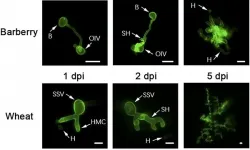(Press-News.org) As one of the founding members of the International Rye Genome Sequencing Group (IRGSG), the University of Maryland (UMD) co-published the first full reference genome sequence for rye in Nature Genetics. UMD and international collaborators saw the need for a reference genome of this robust small grain to allow for the tracking of its useful genes and fulfill its potential for crop improvement across all major varieties of small grains, including wheat, barley, triticale (a cross between wheat and rye that is gaining popularity), and rye. Following the model of international collaboration used when UMD helped sequence the wheat genome, UMD co-developed the idea to produce a reference genome, organized the effort, and contributed to achieve the collective goal. The result is a valuable resource that can help improve grain yield, disease resistance, and temperature tolerance to increase climate resilience in grain crops.
"This reference genome is a wonderful resource, and it opens so many new doors for us," says Vijay Tiwari, assistant professor in Plant Science and Landscape Architecture (PSLA) at UMD and leader of the Maryland Small Grains and Genetics program. "The knowledge that rye offers us to fight physical and disease stressors is going to help us produce better crops that can tolerate disease and climatic changes much better. We can do genome-wide assays to see where useful traits are coming from, and for that, we need a reference genome to provide a framework."
Nidhi Rawat, assistant professor in PSLA and plant pathologist specializing in diseases like Fusarium Head Blight that ravage small grains, adds, "The more we screen, the more we get amazed with how much useful diversity we see in rye. It holds tremendous potential for crop improvement across wheat, rye, triticale, and barley."
Authored by more than 60 scientists from 14 countries including 4 research institutions in the U.S., this collaboration represents truly cooperative science. Based off the example of the International Wheat Genome Sequencing Consortium (IWGSC), Nils Stein of the Leibniz Institute of Plant Genetics and Crop Plant Research (IPK) in Germany took the lead on coordinating with the global collaborators to ensure that all the necessary pieces came together to produce the full rye genome. UMD is proud of the work they did to help bring this idea to fruition.
"Before this, there was significant effort to sequence the rye genome, but the fragmented assembly was not sufficient," says Tiwari. "But in this case, scientists all came together without centralized support because we all decided it was a good idea to get this knowledge out to the community. At UMD specifically, we helped develop the consortium, co-developed the idea, and provided resources to get the sequencing done and complete the mapping work. It was really absolute teamwork."
The excitement for this new rye reference genome can be especially felt across scientific and agricultural communities alike, laying the groundwork for many avenues of future research and crop improvement. According to Tiwari and Rawat, rye has a very diverse set of genes that allows it to grow in all kinds of soil and environments, making it very stress tolerant and disease resistant. It is also a cross-pollinated crop unlike self-pollinating wheat and barley, making it ideal for producing more robust hybrid grain varieties.
"Ancient wheat, barley, and rye all evolved around the same time," explains Tiwari. "But rye took a different path and has some unique advantages to the others. For example, finding ways to make wheat and barley cross-pollinating crops makes it easier to produce hybrid wheat or barley and is a huge incentive for increasing yield. Rye has that capability already."
Rawat and Tiwari also stress that rye and triticale (developed by crossing wheat and rye) are important cover crops for this region because of their efficient use of nutrients and need for little fertilizer, making them great for the Chesapeake Bay. "In addition to being good for bread and beer, rye is a popular cover crop because it has a very good portfolio for nitrogen and phosphorus use efficiency which are specifically very important for keeping excess nutrients out of the Bay," says Rawat. "Recently, we screened hundreds of triticale lines for diseases and found useful genetic diversity that seems to be coming from rye. With the availability of the reference genome of rye, it will be very easy to map the genes underlying these useful traits and transfer them to wheat and other small grains."
Rawat and Tiwari are excited at the breeding and research opportunities that this work can open up across the entire spectrum of small grains, allowing for the development of varieties that can meet the diverse needs of growers worldwide.
"It feels really great to see that in the last three years, we have two reference genomes sequenced for small grains [wheat and rye], and UMD was one of the leaders in both of them," says Tiwari. "It is a useful contribution towards the AGNR initiative to increase global food security."
"I'm particularly excited because it not only shows our research excellence at a national and international level, but the real satisfaction comes that the work we are doing in the lab is actually benefiting farmers at the ground level," stresses Rawat. "That is very fulfilling - that is a reward that is invaluable."
INFORMATION:
This paper, entitled "Chromosome-scale genome assembly provides insights into rye biology, evolution, and agronomic potential," is published in Nature Genetics, DOI: 10.1038/s41588-021-00807-0.
Wheat stripe rust is one of the most important wheat diseases and is caused by the plant-pathogenic fungi Puccinia striiformis f. sp. tritici (Pst). Though Pst is known to be highly host-specific, it is interestingly able to infect two unrelated host plants, wheat and barberry, at different spore stages. Pst infects wheat through its urediniospores and infects barberry with its basidiospores.
"This complex life cycle poses interesting questions on the co-evolution between the pathogen and the hosts, as well the different mechanisms of pathogenesis underlying the infection of ...
The Journal of Anthropological Research has just published a new article on the development of linguistic documentation among heritage language speakers: "Articulating Lingual Life Histories and Language Ideological Assemblages: Indigenous Activists within the North Fork Mono and Village of Tewa Communities."
Specifically, it focuses on the biographical information of individual speakers, and the significance they place on the language in question. Author Paul V. Kroskrity focused his research on two specific communities - the North Fork Rancheria of Mono Indians in California and the Village of Tewa, First Mesa, Hopi Reservation in northeastern Arizona ...
In a study aimed at investigating the mechanism responsible for exacerbating rheumatoid arthritis in smokers, researchers at the Center for Research on Inflammatory Diseases (CRID), linked to the University of São Paulo (USP) in Brazil, discovered a novel path in the inflammatory process associated with the bone damage caused by rheumatoid arthritis. The discovery opens up opportunities for new therapeutic interventions to mitigate the effects of the disease, for which there is no specific treatment at this time.
An article on the study is published in Proceedings of the National Academy of Sciences ...
Lung cancer is the leading cause of cancer death in the U.S. for both men and women. While risk for this disease can be influenced by environmental and lifestyle factors like smoking, studies estimate that 18% of lung cancer cases are due to inherited genetic variants. New research led by Baylor College of Medicine investigates how genetic variants contribute to increased risk of lung cancer.
The researchers performed whole exome sequencing on germline (inherited) DNA from eight large-scale datasets, including 1,045 patients with a family history of lung cancer or early-onset cancer. Those groups are more likely to harbor genetic risk variants. The analysis ...
Researchers at the University of Ottawa have debunked the decade-old myth of metals being useless in photonics - the science and technology of light - with their findings, recently published in Nature Communications, expected to lead to many applications in the field of nanophotonics.
"We broke the record for the resonance quality factor (Q-factor) of a periodic array of metal nanoparticles by one order of magnitude compared to previous reports," said senior author Dr. Ksenia Dolgaleva, Canada Research Chair in Integrated Photonics (Tier 2) and ...
Medical cannabis is a subject of much debate. There is still a lot we do not know about cannabis, but researchers from the Department of Neuroscience at the Faculty of Health and Medical Sciences have made a new discovery that may prove vital to future research into and treatment with medical cannabis.
Cannabinoids are compounds found in cannabis and in the central nervous system. Using a mouse model, the researchers have demonstrated that a specific synthetic cannabinoid (cannabinoid WIN55,212-2) reduces essential tremor by activating the support cells of the spinal cord and brain, known as astrocytes. Previous research into medical cannabis has focussed on the ...
LOS ANGELES (March 18, 2021) -- COVID-19 disproportionately affects men compared with women, raising the possibility that a hormone like progesterone may improve clinical outcomes for certain hospitalized men with the disease. New research from Cedars-Sinai published online in the journal Chest supports this hypothesis.
The pilot clinical trial, involving 40 men, is believed to be the first published study to use progesterone to treat male COVID-19 patients whose lung functions have been compromised by the coronavirus. While the findings are promising, larger clinical trials are needed to establish the potential of this experimental therapy, the investigators said.
The study was prompted ...
In response to the recent freeze-inspired power outages in Texas, some politicians blamed the historic blackouts on wind turbines. The dubious, and largely dismissed, claims nevertheless spotlighted an intriguing fact: Texas, the land made famous by oil derricks and wildcatters, now gets a significant portion of its electricity from clean, renewable sources, most notably wind, but also from water and solar - a troika of sustainability known collectively as WWS.
"Texas gets about 20 percent of its electricity from wind alone," says Mark Z. Jacobson, a professor of civil and environmental engineering at Stanford University and senior fellow at the Stanford Woods Institute ...
Technological advances have made it possible for researchers to track the movements of large ocean-dwelling animals in three dimensions with remarkable precision in both time and space. Researchers reporting in the journal iScience on March 18 have now used this biologging technology to find that, for reasons the researchers don't yet understand, green sea turtles, sharks, penguins, and marine mammals all do something rather unusual: swimming in circles.
"We've found that a wide variety of marine megafauna showed similar circling behavior, in which animals circled consecutively at a relatively ...
What The Article Says: An oncologist reflects on how advising patients with cancer about travel during a pandemic requires a nuanced consideration of benefit and risk, especially when considering lost opportunities when prognosis is limited.
Authors: Christopher E. Jensen, M.D., of the University of North Carolina School of Medicine in Chapel Hill, is the corresponding author.
To access the embargoed study: Visit our For The Media website at this link https://media.jamanetwork.com/
(doi:10.1001/jamaoncol.2021.0125)
Editor's Note: The article includes conflicts of interest disclosures. Please see the article for additional information, including other authors, author contributions and affiliations, conflict of interest and financial ...





